The early years Adelaide 1928-1939
A pictorial history compiled by Geoff Goodall
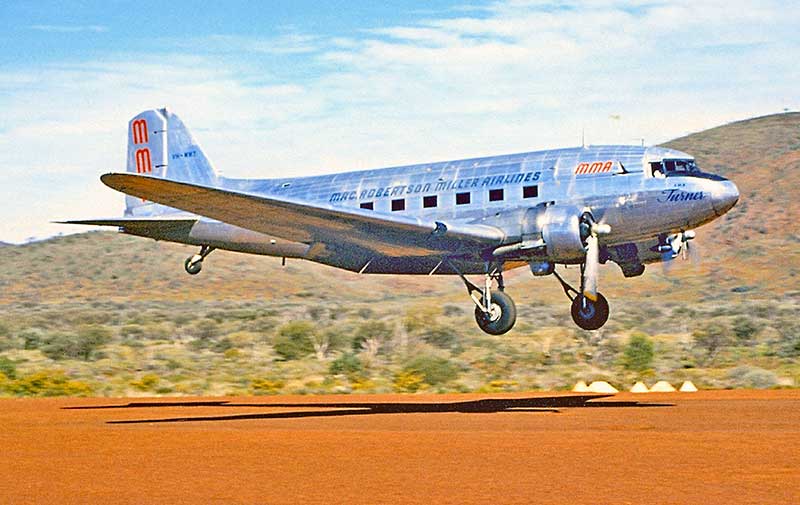
Miller ordered the DH.61 from England and in May 1928 a new company MacRobertson-Miller Aviation Company Ltd was reguistered in Adelaide. Miller continued operating charter and joy fights under his original company Commercial Aviation Company, Adelaide. The new airline's business was conducted through the MacRobertson company office in Adelaide which ensured the struggling flying venture was run on sound business lines. An early example came when the Civil Aviation Branch decided in 1927 that Albert Park aerodrome, where Miller had his hangar, was to close and Parafield would be the new aerodrome for Adelaide. The cost of moving his hangar and equipment worried Miller for some months until MacRobertson's Adelaide Manager firmly put it to the CAB that it was their responsibility to cover the cost of the move, which was accepted.
Born in April 1893 at Creswick near Ballarat Victoria, his mother died of typhoid fever when he was only 6 months old. After a harsh childhood, from age 11 he fended for himself in Melbourne and dropped out of school. Living on casual jobs, he became fascinated by aviation and among his friends was a young Harry Hawker before he left for England. In 1914 Miller booked a ship's passage to England with hopes of finding a career in aviation. He gained employment at the Sopwith factory where he learnt about aircraft construction and engines and spent much time with Harry Hawker who was their test pilot. At the outbreak of war in 1914 Horrie Miller returned to Melbourne determined to join the Australian Flying Corps. While waiting for his intake at Point Cook, he built his own design biplane in a blacksmith's shop in Melbourne. He test flew it only twice before commencing flying training at Point Cook. He returned to England with his pilots course by troopship and flew as a fighter pilot with AFC No.3 Squadron in France, reaching the rank of Lieutenant.
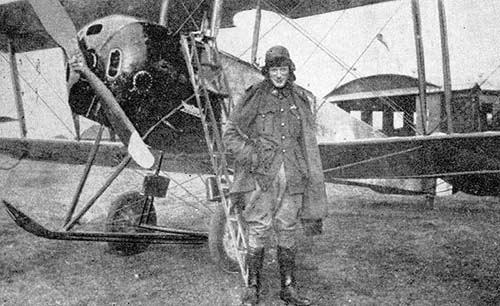
Horrie Miller and Art Kennedy agreed to form a partnership and promptly registered their business as Commercial Aviation Company, Rochester Victoria on 8 October 1920. The F.K.8 was assembled at Glenroy aerodrome, Melbourne and Miller flew it to Rochester, still wearing its RAF serial H4561. The plan was to commence with joyriding to build up finances, with Horrie Miller as the pilot and Arthur Kennedy selling the tickets and keeping the books. From October 1920 they began a series of joyriding tours across Victoria and South Australia. Their F.K.8 carried two or even three passengers in the widened rear open cockpit and was registered G-AUCF when the Australian Civil Aircraft Register was established in June 1921.
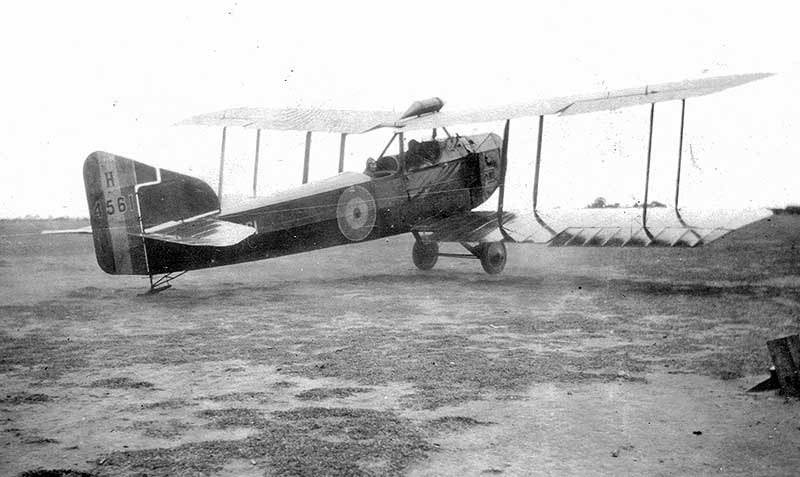
Photo: Kennedy family archives via John McCulloch
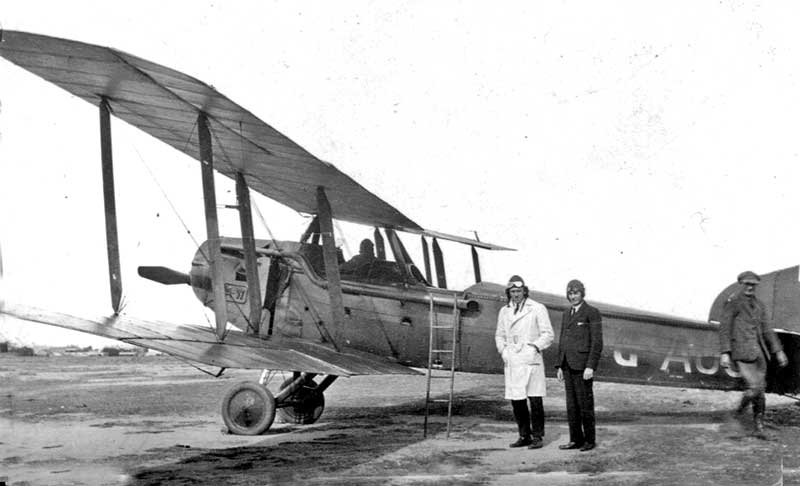
G-AUCF was registered to Commercial Aviation Company (A.A.Kennedy and H.C.Miller), Rochester Victoria.
Photo: Kennedy family archives via John McCulloch
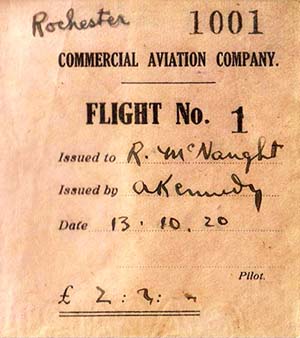
Courtesy John McCulloch
Miller's planned flying boat service from Adelaide to SA coastal towns used two Curtiss Seagulls G-AUCU & -UCV which were loaned by Sydney businssman and aviator Lebbeus Horden. Miller dismantled both at Double Bay, Sydney and had them shipped to Adelaide where he had leased a dirt-floored hangar at Albert Park aerodrome. He flew them on joy rides from Adelaide suburban beaches, using an achorage at Outer Harbour but found their operation exhausting due poor performance and continuous problems due rough seas and windy weather. His proposal for flying boat passenger services to SA country towns failed to gain any backing from the state government.
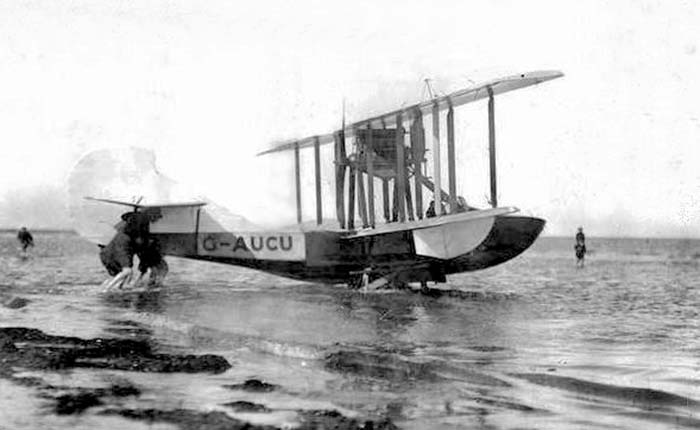
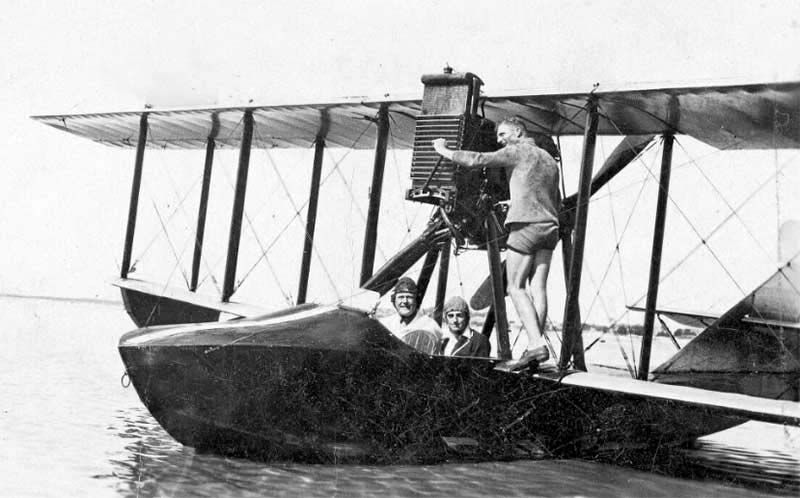
Photo: National Library of Australia, Horrie Miller collection
A few days after flying the Bristol to Melbourne, Miller haappened to meet Hudson Fysh of Qantas Ltd, who was deperately seeking replacement aircraft to maintain their Queensland services. Qantas had just rejected the appalling Vickers Vulcan "luxury airliner" which had been delivered to Longreach by the ill-tempered and foul-mouthed Vickers demonstration pilot Geoffrey Wigglesworth. The Vulcan failed all its acceptance performance tests at Longreach and the purchase was cancelled. Fysh promptly offered the Vickers refund cheque to Miller for G-AUEB provided he delivered it at his own risk to Longreach within the next few days.. This he did and the Bristol was handed over to Qantas at Longeach on 28 April of the same month that Miller had assembled it at Richmond!
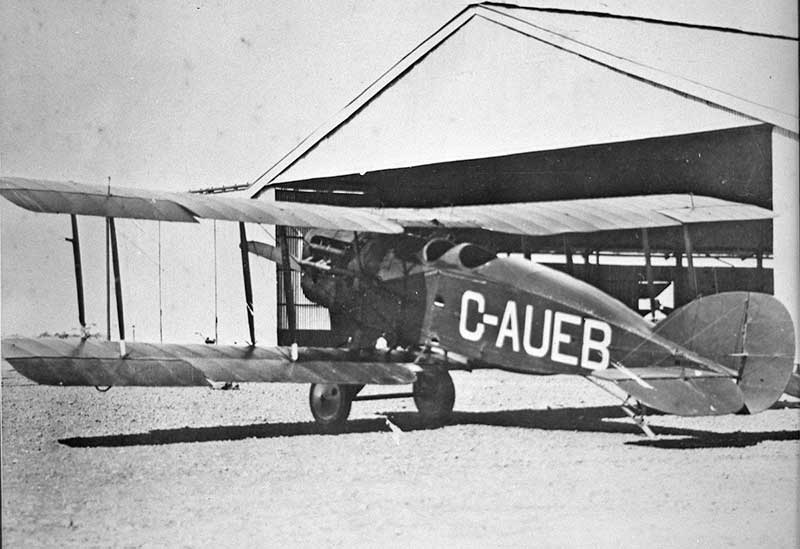
H.C.Miller's
Bristol Tourer at Longreach shortly after he delivered it to Qantas in
April 1923. Qantas later built
a cover over the rear passenger compartment, of similar design to the West Australian Airways Tourers.
Photo: National Library of Australia, Horrie Miller collection
a cover over the rear passenger compartment, of similar design to the West Australian Airways Tourers.
Photo: National Library of Australia, Horrie Miller collection
Miller spent his profit from the Bristol sale by placing an order for
a bigger DH.9 biplane from England. Knowing it would be many months before
it arrived by sea, he took a job in Brisbane flying joyrides in an Avro
504K G-AUDR owned by a Brisbane motor garage. The 100hp Sunbeam Dyak engine
gave a dangerously inadeqate performance, so Miller suggested re-engining
it with a 160hp Curtiss K6 from the two Seagulls stored in Adelaide. He
removed the engine and took it to Brisbane where he installed it in the
Avro, using new engine mounts he made from Queensland maple wood. The
improvement in performance was so great that they owners entered it in
the 1924 Aerial Derby at Richmond NSW which was offering cash prizes.
Miller beat old friend Edgar Percival in a 50 miles closed circuit air
race and won two cups and a £100 prize.
Now settled in Brisbane, Miller had the other Curtiss Seagull G-AUCV with engine shipped from Adelaide to Brisbane. He assembled it at the Hamilton Reach slipway near the Ascot Hotel and started flying it on joyrides in December 1924, mostly at Southport. The income was welcome but again he faced continual problems find safe anchorages along the Brisbane River and the hull was holed on submerged piles. When his DH.9 arrived in Brisbane from England, Miller was relieved to leave the flying boats to Lebbeus Hordern.
Miller assembled his Airco civilianised DH.9 in Brisbane. It was registered G-AUEU to H.C. Mller on 14 May 1925. He later wrote "This machine had a speed of a hundred miles an hour and was the first I had owned that gave a really good performance. Looking along her nose with its whisting Siddeley Puma engine standing clear of the cowling, I felt confident of being able to embark at last on a permanent flying business."
But first he accepted an offer from the RAAF to supervise the engine repair workshop at Point Cook, flying down from Brisbane in his DH.9. Less than year later Miller returned to civilian life, departing Point Cook in the DH.9 for Adelaide to fly joy rides while looking for opportunities. He shared the same hangar as earlier at Albert Park aerodrome, which was now used by H.J. Larkin's Australian Aerial Services for scheduled services to Melbourne and Sydney. Horrie Miller's friendly association with Larkin gained him charter and maintenance work along the Larkin route network, resulting in he and his DH.9 being in Melbourne more than Adelaide.
Now settled in Brisbane, Miller had the other Curtiss Seagull G-AUCV with engine shipped from Adelaide to Brisbane. He assembled it at the Hamilton Reach slipway near the Ascot Hotel and started flying it on joyrides in December 1924, mostly at Southport. The income was welcome but again he faced continual problems find safe anchorages along the Brisbane River and the hull was holed on submerged piles. When his DH.9 arrived in Brisbane from England, Miller was relieved to leave the flying boats to Lebbeus Hordern.
Miller assembled his Airco civilianised DH.9 in Brisbane. It was registered G-AUEU to H.C. Mller on 14 May 1925. He later wrote "This machine had a speed of a hundred miles an hour and was the first I had owned that gave a really good performance. Looking along her nose with its whisting Siddeley Puma engine standing clear of the cowling, I felt confident of being able to embark at last on a permanent flying business."
But first he accepted an offer from the RAAF to supervise the engine repair workshop at Point Cook, flying down from Brisbane in his DH.9. Less than year later Miller returned to civilian life, departing Point Cook in the DH.9 for Adelaide to fly joy rides while looking for opportunities. He shared the same hangar as earlier at Albert Park aerodrome, which was now used by H.J. Larkin's Australian Aerial Services for scheduled services to Melbourne and Sydney. Horrie Miller's friendly association with Larkin gained him charter and maintenance work along the Larkin route network, resulting in he and his DH.9 being in Melbourne more than Adelaide.
Until he had a suitable aircraft to start the Broken Hill service, Miller was kept busy with charters, joyrides, aerial photography and medical emergency flights, carrying out all flying and maintenance himself.
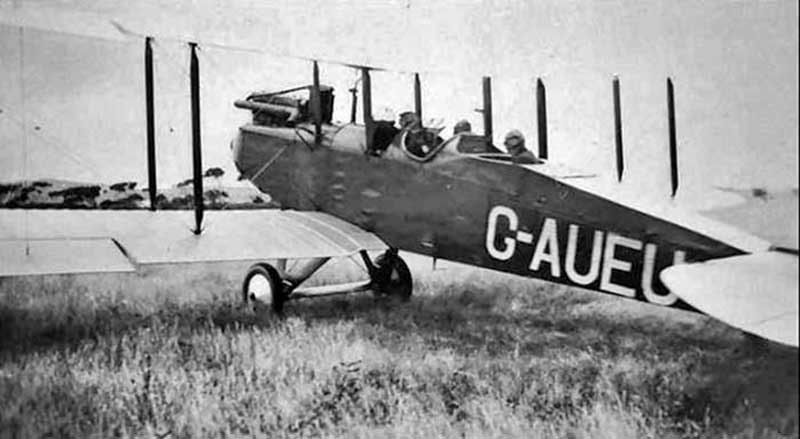
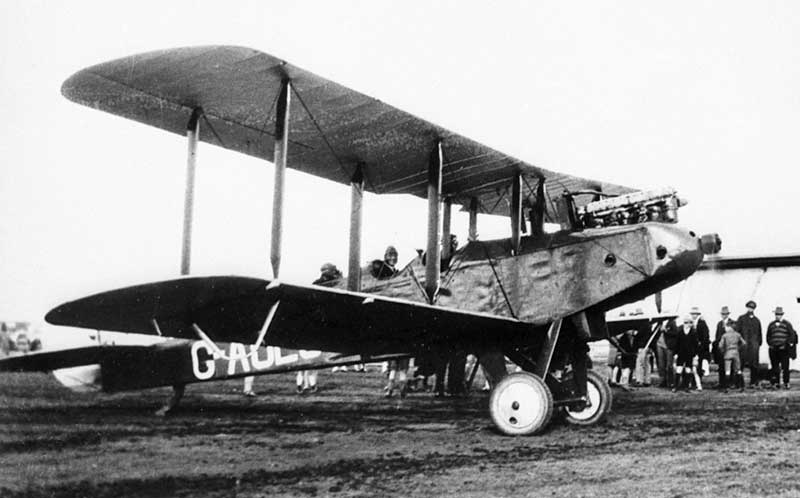
To commence the Adelaide-Broken Hill air service, Miller had decided on the new De Havilland DH.61 Giant Moth which was the latest British design. It was a large biplane with a good performance which carried 8 passengers in an enclosed cabin. But serious financial backing was needed to purchase such an aircraft and set up a scheduled airline service. It was a big step for Horie Miller to accept that his days of operating on a completely independent basis were coming to an end.
"What sort of machine do you have in mind?"
I told him I thought the ideal aircraft for the purpose was the DH.61 Giant Moth.
"How much?"
"About £5,000"
He asked a few more questions and and made some quick calculations on his blotter.
"Alright" he smiled "we'll call it a partnership if you like, but on one condition."
I waited anxiously.
"I would like the machine to be named "Old Gold".
At this we all laughed and shook hands, Old Gold being MacRobertson's most famous brand of chocolates."
A new DH.61 Giant Moth was ordered from De Havilland's Australian subsidiary De Havilland Aircraft Pty Ltd, Melbourne. The machine was actually the prototype DH.61, first flown on 6 December 1927 at the DH Stag Lane works as G-EBTL. Its log book shows numerous test flights from Stag Lane by DH pilots Hubert Broad, A.S.Butler and Geoffrey deHavilland for the new type's British certification. The last flight was 4 January 1928 after which it was dismantled and packed for shipping to Australia to customer Commercial Aviation Co, Adelaide. Always with a mind for economy, Horrie Miller wrote to the Australian Civil Aviation Branch requesting an Australian civil registration which would require minimum repainting and was obligingly issued with G-AUTL.
The big biplane with its 450hp Bristol Jupiter engine was unloaded at Port Melbourne in late February 1928 and taken to Essendon Airport for assembly. On 3 March 1928 it was test flown at Essendon by Major Hereward de Havilland, manager of the Australian DH company. Later that same day he checked out Horrie Miller on his new aircraft, and Miller took it for local flights over the next few days.
It was repainted as G-AUTL, with the name Old Gold on the fuselage under the passenger windows. To gain publicity for the new aeroplane, MacPherson Robertson suggested Horrie deliver it to Adelaide with the cabin filled with MacRobertson's chocolates, which was done on 8 March 1928.
Miller now conducted his business through MacRobertson's Adelaide office which he found to be an excellent arrangement. He received a salary of £5 per week which remained unchanged for many years. Scheduled airline services commenced with Adelaide-Renmark but expanded to include Whyalla, Kimba, Kangaroo Island, Streaky Bay, Mount Gambier and Broken Hill.
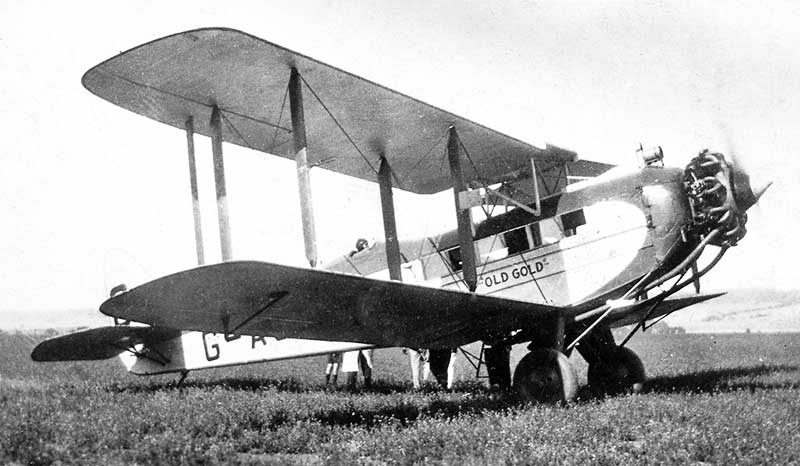
Photo: Allan Betteridge Collection, Civil Aviation Historical Society
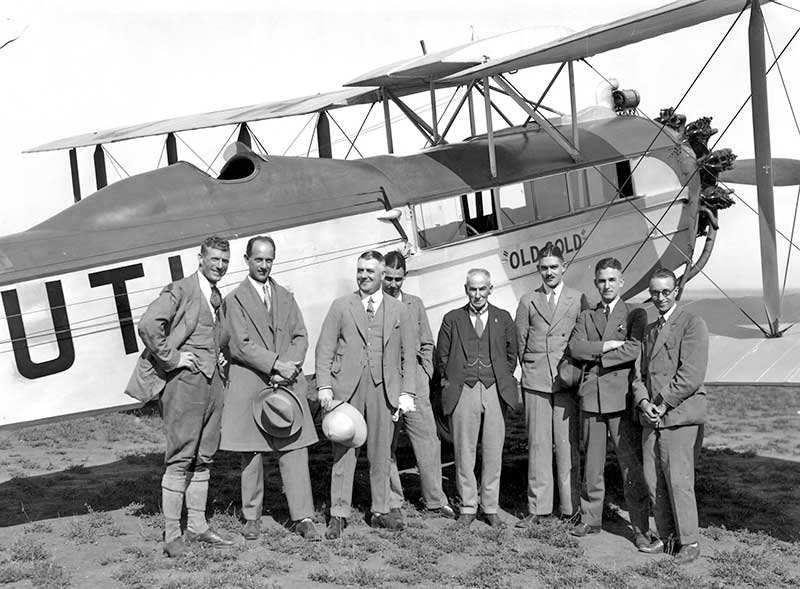
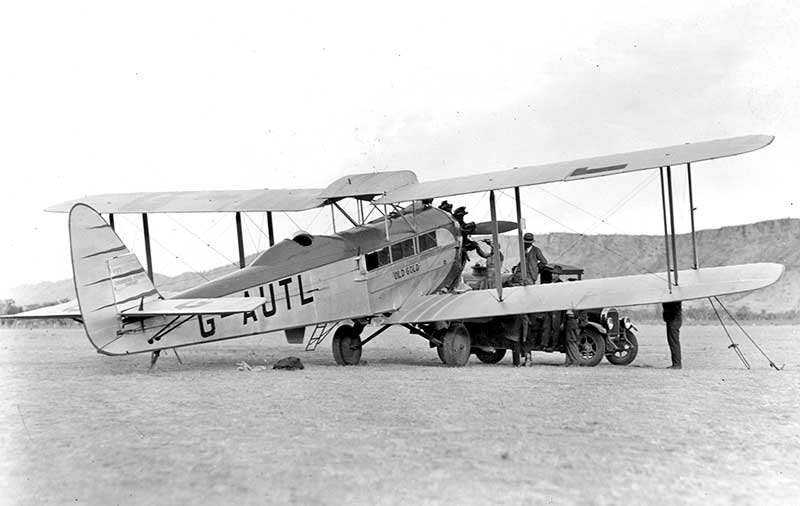
A second airliner was needed and he had decided on the 6-passenger Fokker Universal range. Learning of an Universal being offered for sale by an American building firm, a deal was struck. It was US-built under licence from Fokker by the Atlantic Aircraft Corp at Teterboro New Jersey, fitted with a 220hp Wright Cyclone. Fortunately it was already at sea bound for Adelaide when the Civil Aviation Branch imposed a ban on importing US built aircraft because the United States was not a signatory to the International Convention for Aerial Navigation (ICAN). The Fokker was registered G-AUJT on 16 January 1929, changing to VH-UJT later that year when the new Australian registration series came into effect.
The Universal gave MMA long service but was underpowered. Miller later
replaced the Wright radial with a P&W Wasp Junior which gave an
additional 160hp for takeoff. He wrote: "I
felt excited as I taxied out for the first air test at Parafield. On
opening the throttle to takeoff I sensed instantly that the experiment
was a grand success. The machine took to the air in half the usual distance,
climbing easily with a big reserve of power and within an hour I was
on my way to Fowler's Bay on a medical emergency flight. That Fokker
carried many thousands of passengers and hardly anything was spent on
reconditioning."
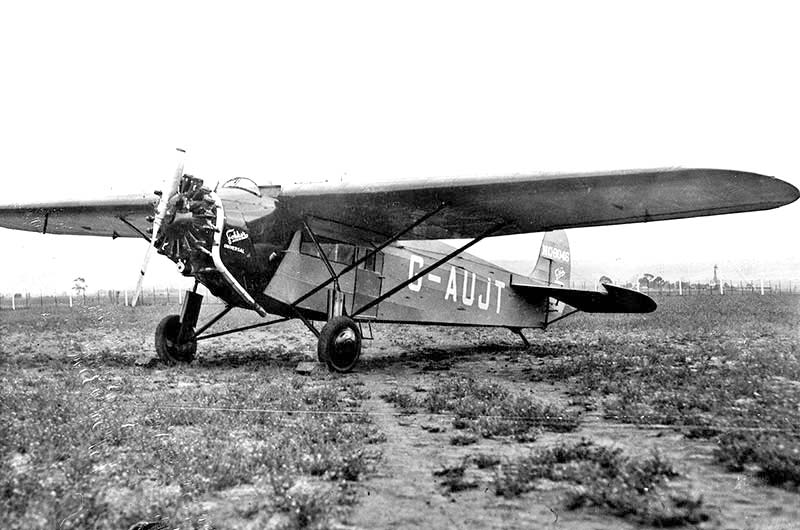
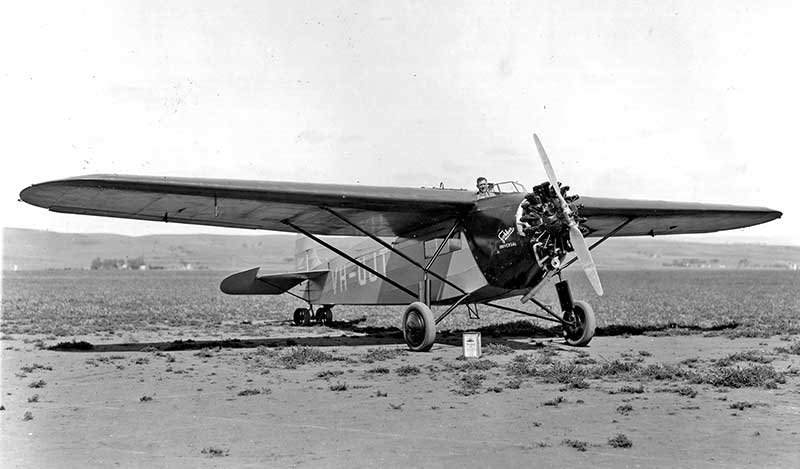
The cabin carried 6 passengers . Photo: D.Darien Smith via SA Aviation Museum
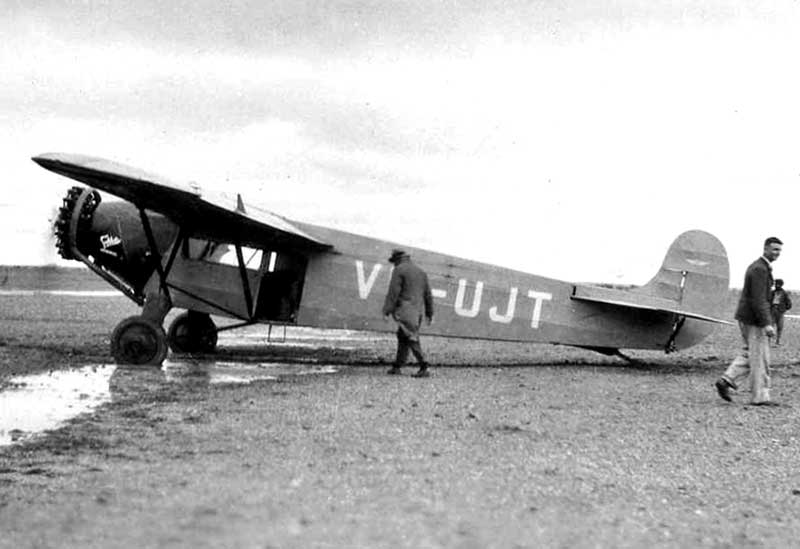
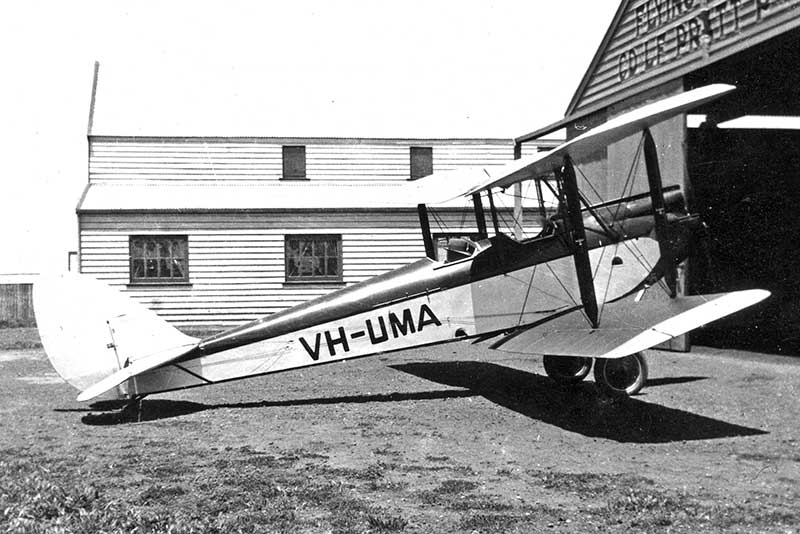
Photo by Charles D. Pratt
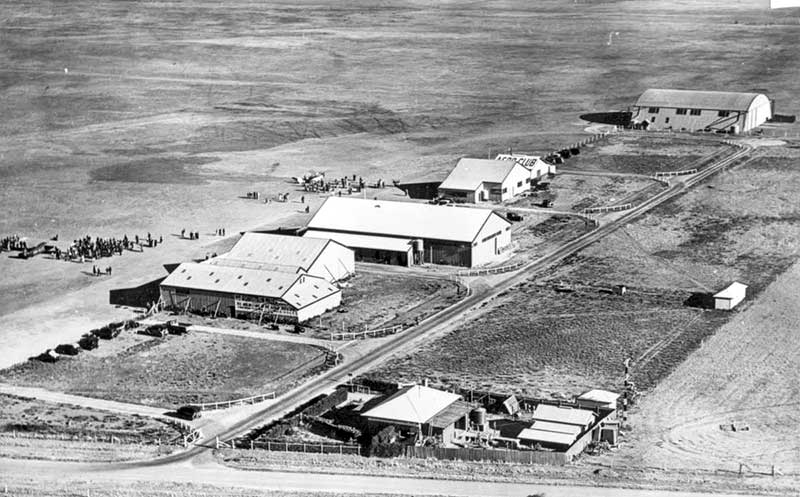
Parafield
1930. The two closest hangars were MMA, then the Aero Club and West Australian
Airways hangar at the top.
Photo: Civil Aviation Historical Society
Photo: Civil Aviation Historical Society
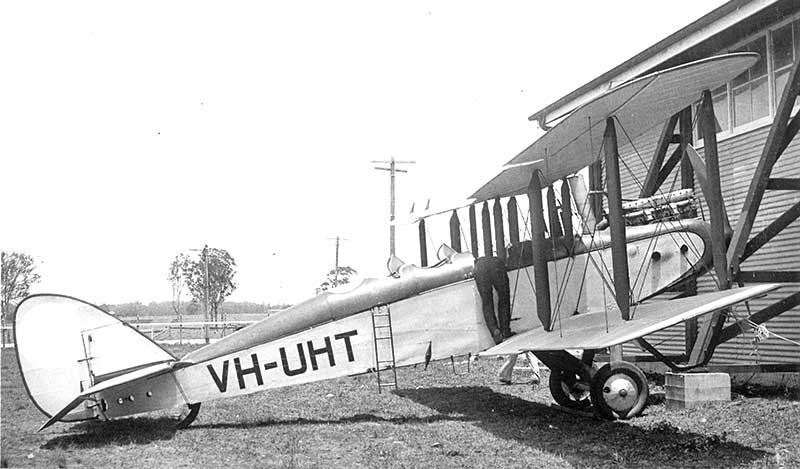
Photo Reddall collection, via AHSA NSW Branch
"I purchased the Bristol from the widow of the late Captain Harry Butler. It was hung from the rafters of a garage in Adelaide and the caster-oil stained fabric of both the fuselage and wings was a sorry sight. I stripped off all the fabric and redesigned the nose section to take a Gipsy II engine mounted upright. The discarded Le Rhone rotary engine went to Les Hannan of Adelaide. When I finished the overhaul I did not have a Gipsy II available so I borrowed a Gipsy I from Percy Knapman. With that engine, I won the Adelaide Aerial Derby and in the following yeasr I won again but the Aero Club disallowed the win on some technical timing business."
The Bristol was completed at Parafield in silver finish with pale blue undersides and registered VH-UQI to H.C.Miller in October 1931. The name "Puck" was painted on in blue, in honour of a close friend Hugh "Puck" Grosvener who had been killed in a flying accident. The planned 120hp Gipsy II engine was then installed.
Civil Aviation Board requirements at that time stipulated that single-seat aircraft did not require a Certificate of Airworthiness. This was to become an issue later when Miller entered the Bristol in the 1936 Brisbane-Adelaide Air Race. A routine requirement for entrants was that their aircraft hold a current CofA, but the newly reorganised Civil Aviation Branch refused to issue a Certificate because of the modified engine installation. Horrie felt his five years of flying validated the aircraft's airworthiness and was angry that such a bureaucratic matter stopped his good chance of winning the race prize money. He wrote bitter letters to the Civil Aviation Branch, the Minister, British Air Ministry and Australian newspapers. But the CAB would not relent and he was forced to scratch his entry. VH-UQI was retired and struck-off the Civil Register.
(The CAB pay-back came two years later when Miller test flew the Bristol at Parafield in April-May 1938. In a series of officious letters the CAB restricted him to flights within 5 miles of Parafield, then stipulated no aerobatics permitted, and as a final barb, required prior CAB permission before each flight. Miller threatened to take legal action against the Government and flew the Bristol without prior approval)
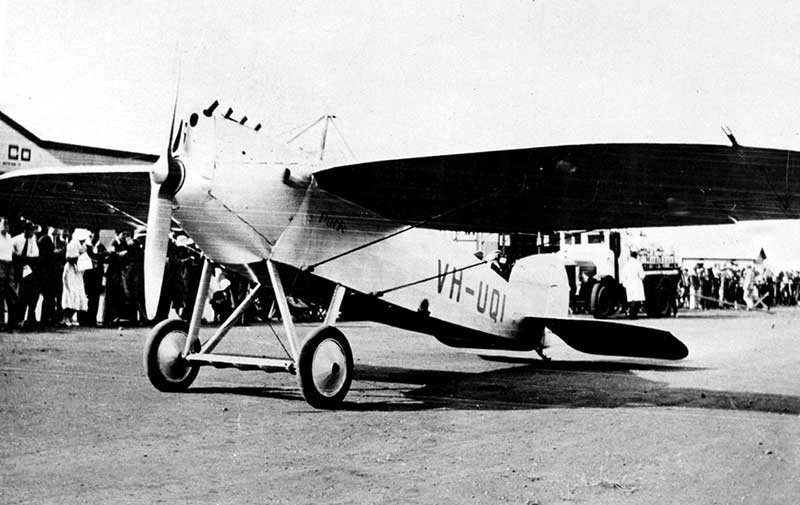
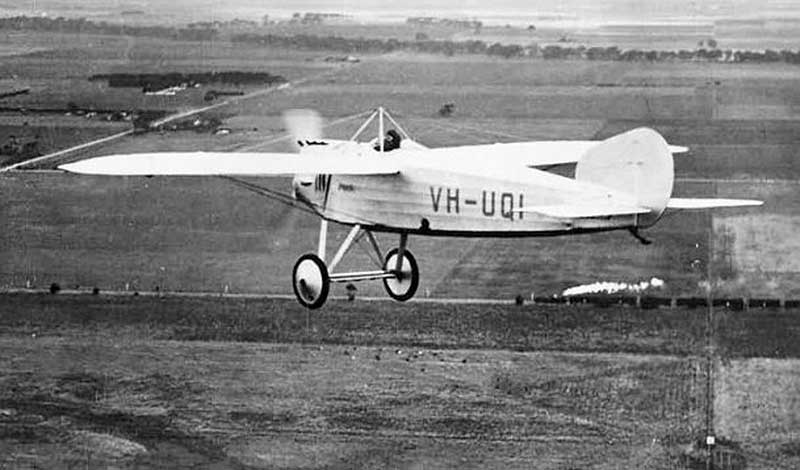
National Library of Australia, Horrie Miller Collection
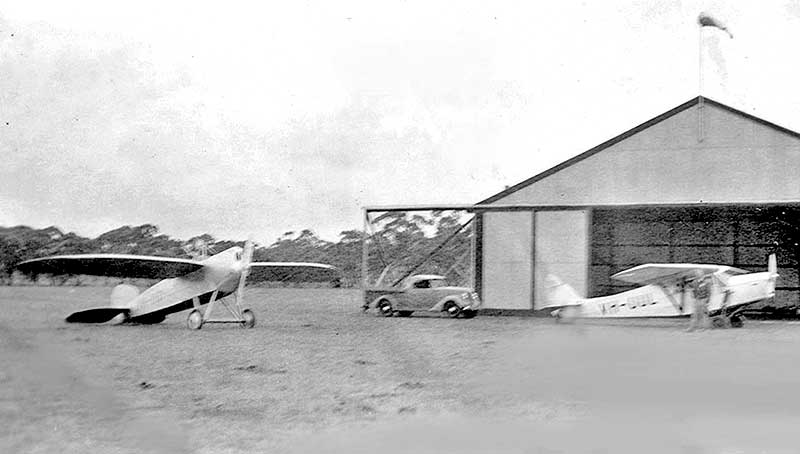
who had learnt to fly with MMA's Mount Gambier flying school in 1930. Keith is standing with his Leopard Moth VH-UUL.
Photo courtesy Keith's Grandson Justin Good
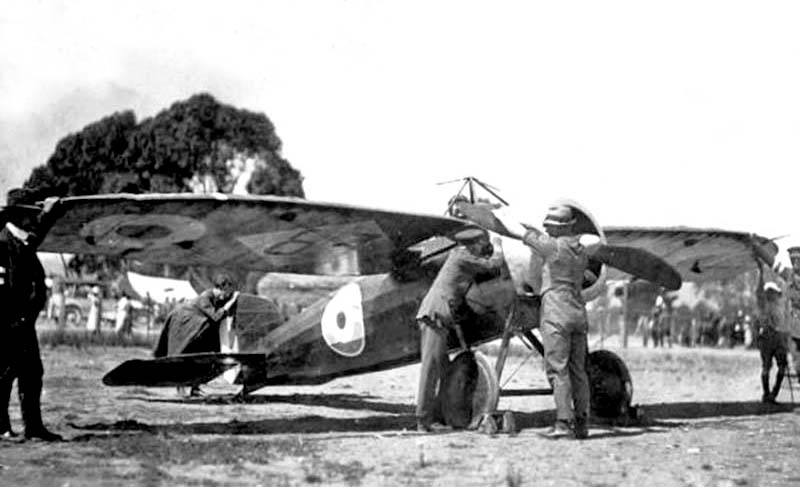
All red RAF markings serial C5001 with a Le Rhone rotary engine. Photo: Kevin O'Reilly collection
The Giant Moth DH.61 VH-UTL Old Gold was not being utilised and had to be placed up for sale. The only potential buyer at that time was West Australian Airways and Miller invited WAA chief pilot James Woods to take it for a test flight at Parafield on 27 February 1931. Woods was in Adelaide while flying the scheduled WAA DH.66 Hercules service from Perth. A sale was negotiated requiring Miller to deliver Old Gold to Perth. He left Parafield on 30 April 1931 and reached Perth late the following day when Norman Brearley took it for an acceptance flight and payment was made.
MMA's commercial operations at Adelaide continued with the Fokker Universal and DH.9. General charter flying and aircraft maintenance was carried out under both names MMA and Commercial Aviation Co. Miller now engaged a number of engineer/pilots to join Max Campbell, including Bert Hussey and Cyril Kleinig.
These were early days of airline flying before the bulk of rules, regulation and restrictions were devised. The following, as told by Horrie Miller, gives an idea of the individual determination and fortitude of the pilots:
"One morning Bert Heath came running into my Parafield hangar with his hand wrapped in a handkerchief, saying that while taxiing out for takeoff for Perth he had cut off the tip of a finger between the chain and sprocket which operated the controls. He asked me if I would fly the Hercules to Perth, to which I replied that I had never as much as sat in such a machine, let alone flown any aircraft with three engines. I could see that he was in pain and in no fit state to fly, so I followed him out to the aircraft where he briefly demonstrated the controls. He then left me in charge of this giant of the air with its full load of 17 unsuspecting passengers reading their newspapers.
I taxied to the furthest edge of the aerodrome and turned into wind. The takeoff was normal, the three engines easily lifting the great weight as I headed out over the Gulf. Before long, with the ground temperature at 112 degrees (F) the cockpit was like a furnace and I was pleased to notice a two gallon water bag in a corner. I had some anxious moments coming down for the landing at Ceduna and went over and over again Bert's hasty instructions, but got away with it all right. The journey from there on was a triumphal progress as I gained confidence with each landing and takeoff. Unusually heavy rain had soaked the aerodrome surface at Forrest and Jim Woods, who had received a wire from Adelaide was waiting for me with a white bed sheet spread on the only dry piece of land. "
In a surprise decision which shocked the Australian aviation community, the Government awarded the WA coastal route to MMA, taking it from WAA which had operated the arduous remote route since 1921. The new arrangements would commence in October 1934 with the northern terminus extended from Wyndham to Daly Wayers where mail would be transferred with the Qantas aircraft flying the Singapore-Brisbane service. The MMA tender specified three new DH.84 Dragons and orders were placed.
Early in 1934 Miller flew to Perth in MMA DH.60M Moth VH-UNX to begin the task of setting up a new airline organisation in WA. He needed a chief pilot who knew the route and persuaded WAA chief pilot Captain James Woods to take up the role. The deal was made even more attractive by the plan that Woods would be sent to England to fly the Lockheed Vega Gull which Miller had entered in the October 1934 London-Melbourne Air Race. Horrie Miller would be staying in WA to manage the introduction of the new air service.
Kleinig had also began with Miller as a young man willing to work in the Parafield hangar without pay just to be close to aviation. Miller soon taught him to fly and Kleinig took over much of the flying. In later years Kleinig went on to become Managing Director of MMA in Perth.
As the effects of The Great Depression eased, a new airline service Adelaide-Port Pirie-Whyalla-Kimba-Cowell. He applied for a Federal Government subsidy and was partly succesful, having the Adelaide-Whyalla sector only subsidised. The route was to continue until 1939 with changes to Eyre Peninsula towns served.
A three passenger DH.83 Fox Moth VH-UDD was added in January 1936. It had previously been used as a joyrider by the famous C.W.A.Scott Air Displays flying circus, which performed across Great Britain. Sold to MMA in October 1935 it was despatched as boxed cargo on board the S.S.Comorin for Australia. The ship reached Perth on 17 December 1935 where the aircraft was assembled in the MMA hangar at Maylands Aerodrome. Painted with its new Australian registration VH-UDD (at that time the CAB was allocating previously unused earlier registrations), it departed Maylands on 7 January 1936 for Adelaide flown by Cyril Kleinig and carrying Horrie Miller as a passenger in the cabin. Although Miller was now Perth-based, he regularly visited the MMA Parafield business, as well as seeing his old Adelaide friends.
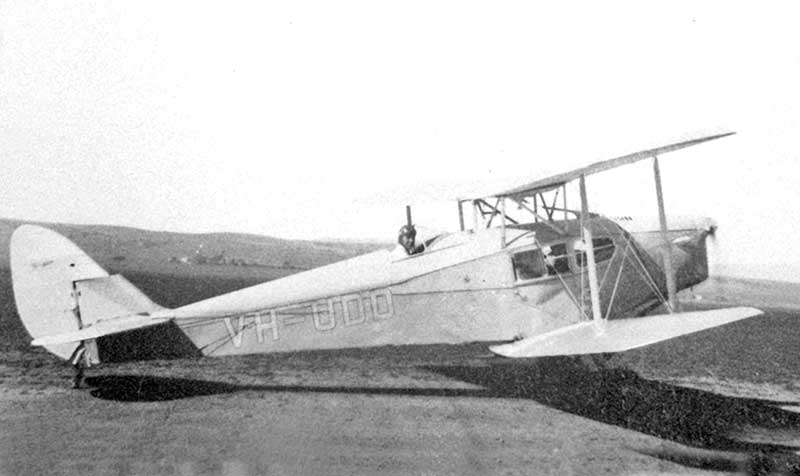
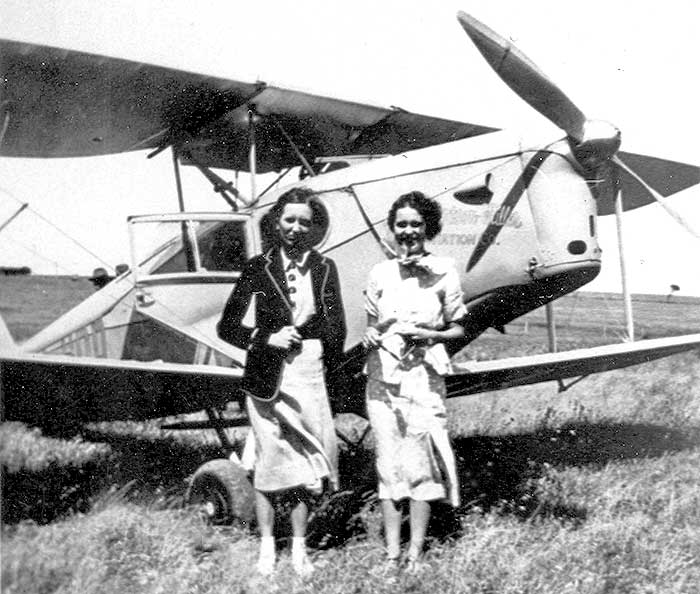
chocolate brown in the MacRobertson's chocolates style script. David Vincent collection
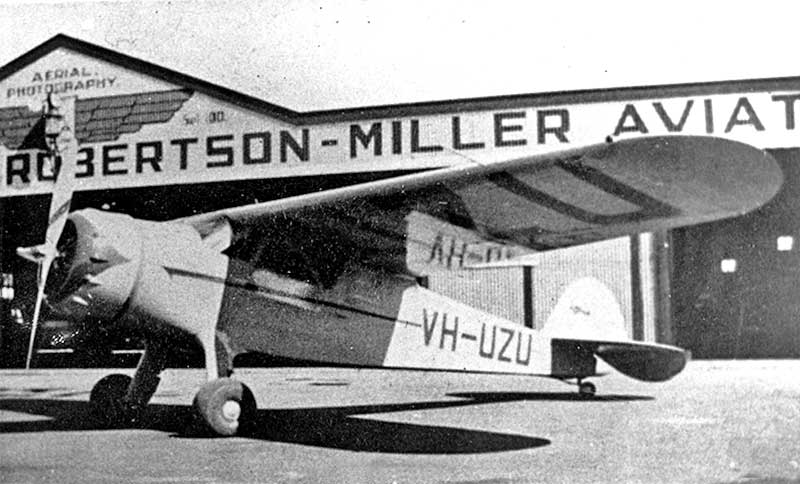
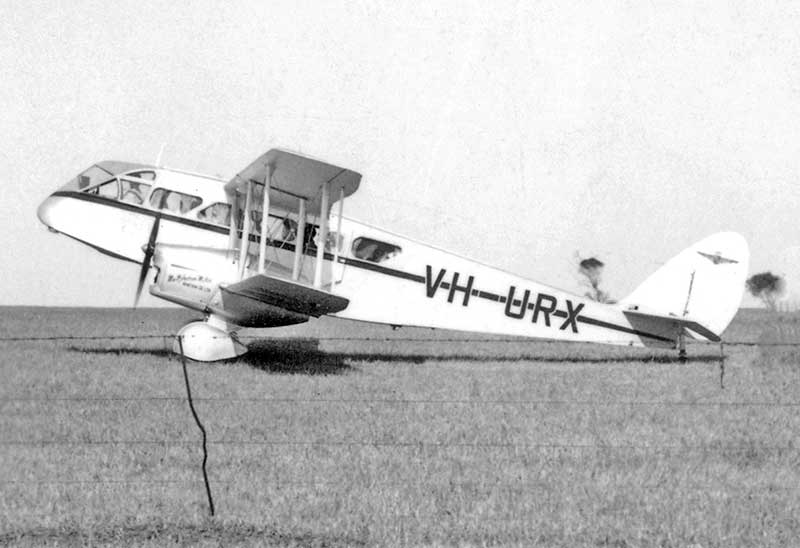
MMA name is on the engine cowling and company winged badge on the rudder. Photo: John Hopton collection
The only other aircraft was Horrie Miller's Bristol M1C VH-UQI, the subject of much unpleasantness between Miller and the CAB in the past. It was no longer on the Civil Register, so Miller wrote to the new Deparment of Civil Aviation on 12 December 1939 requesting approval to fly it to Perth because his company's Adelaide operations had now ceased. DCA's refusal sparked months of correspondence from Miller to DCA and the Minister for Air. In April 1940 DCA approved the one-off ferry flight with a long list of restrictions. Horrie Miller departed Parafield in the silver Bristol on 9.30am on 2 May 1940 for the flight to Perth, where it was parked in the MMA hangar at Maylands Aerodome.
Never one to give up, in February 1942 Miller wrote to DCA stating that because of the war situation he had lost aircraft and pilots to the military. He requested approval, in the interests of the war effort, to use the Bristol for his personal fast communication use in the event of MMA aircraft accidents or breakdown. The DCA file has no written reply to his request, which is the final enclosure in VH-UQI's file which was then closed. By 1953 the Bristol was dismantled in the rafters of the MMA engine workshop at Guildford Airport, Perth.
In 1956 Mr. C. B. Tilbrook, owner of Aviation Services (SA) Ltd, an aircraft maintenance and sales business at Parafield was visiting Perth and saw the Bristol in storage. Tilbrook was an admirer of Captain Harry Butler and began moves which culminated in Horrie Miller agreeing to donate the aircraft to the people of Butler's home town Minlaton SA. The Bristol was transported by road to Adelaide and restored by Aviation Services at Parafield, repainted all red as the Red Devil, but with Miller's later registration VH-UQI and name "Puck". A display building was completed at Minlaton, which was officially opened as the Harry Butler Memorial on 11 October 1958, displaying the Bristol and other artifacts.
Later the Bristol was refurbished, an orginal Le Rhone rotary engine re-installed, and repainted accurately as Harry Butler's
Red Devil. It remains on display at Minlaton today.
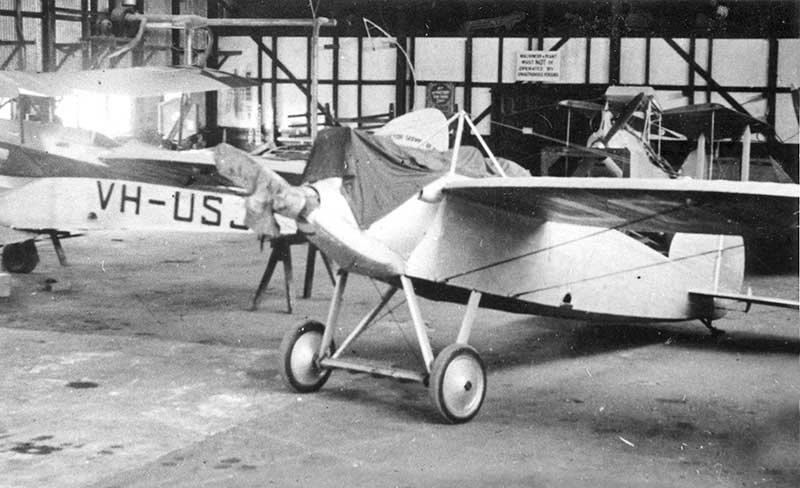
Geoff Goodall collection
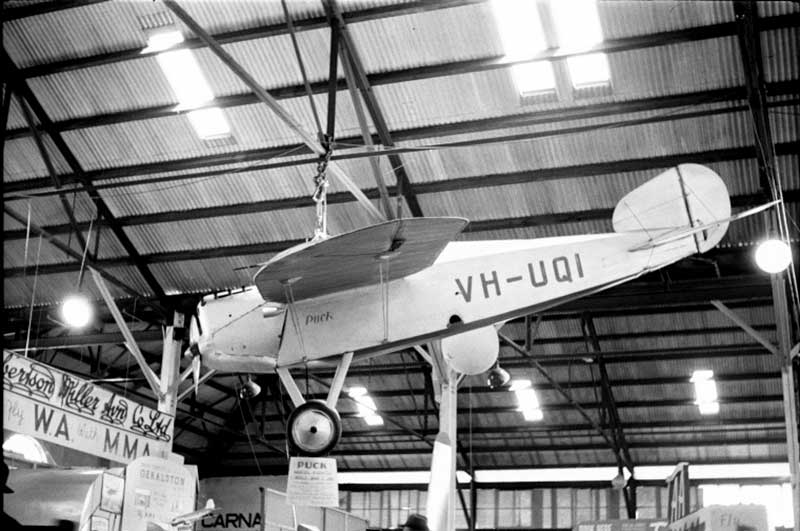
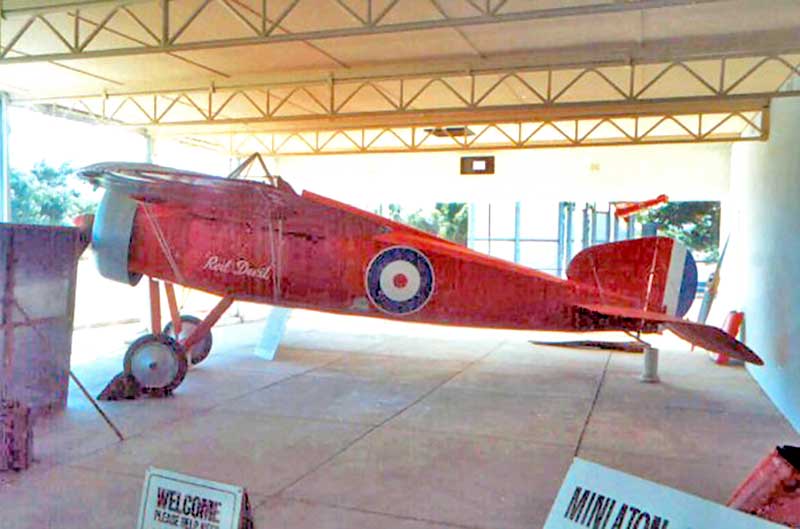
| DH.9 |
G-AUEU |
- |
- |
Wrecked by windstorm
Port Pirie SA 16.2.28. Rebuilt as G-AUHT |
| DH.61 Giant Moth |
G-AUTL VH-UTL |
325 |
G-EBTL |
Registered 3.28 Old
Gold Sold 4.31 to West Australian Airways, Perth |
| DH.9 |
G-AUHT VH-UHT |
- |
G-AUEU |
Registered 7.28, rebuild
of G-AUEU at Parafield Sold 9.36 to Skyways Ltd, Adelaide |
| Atlantic-Fokker F.XI Universal | G-AUJT VH-UJT |
436 |
NC8046 |
Registered 1.29 Sold 21.4.39 to Catholic Mission, Alexishafen, New Guinea |
| DH.60G Gipsy Moth |
G-AUJX VH-UJX |
838 |
New |
Registered 1.29, several
crashes and rebuilds Sold 10.35 to Royal Aero Club of WA |
| DH.60G Gipsy Moth |
VH-UMA |
1088 |
New |
Registered 9.29, crashed 9.10.29 Ardrossan
SA Rebuild completed 2.30 sold 20.11.30 to L.F. & C.D. Pratt, Geelong Flying School |
| DH.60M Moth |
VH-UNX |
1400 |
New |
Registered 5.30 Crashed 7.11.34 Ord River Station WA |
| DH.60M Moth |
VH-UMR |
1399 |
Purchased 13.4.31 as crash wreck, rebuilt
at Parafield Sold 30.8.32 to K.Gardner, Melbourne |
|
| DH.83 Fox Moth |
VH-UDD |
4063 |
G-ACGN |
Registered 1.36 Sold 1.40 to Madang Aerial Transport Co, New Guinea |
| Cessna C.37 |
VH-UZU |
357 |
New |
Assembled Parafield 8.37, test flown
28.8.37 Departed Parafield 19.12.39 to be based Perth |
| DH.84 Dragon |
VH-URX |
6081 |
Ferried to Parafield 9.38 from MMA
Perth Based Parafield until impressed by RAAF 12.39 Delivered Parafield-Point Cook 27.12.39 by James Woods to RAAF A34-1 |
|
| Bristol M1C Monoplane |
VH-UQI |
2819 |
G-AUCH C5001 |
Owned by H.C.Miller Registered 10.31, rebuild of Harry Butler's Red Devil G-AUCH, which last flew January 1922 then stored. Donated .56 by Miller to the town of Minlaton SA |